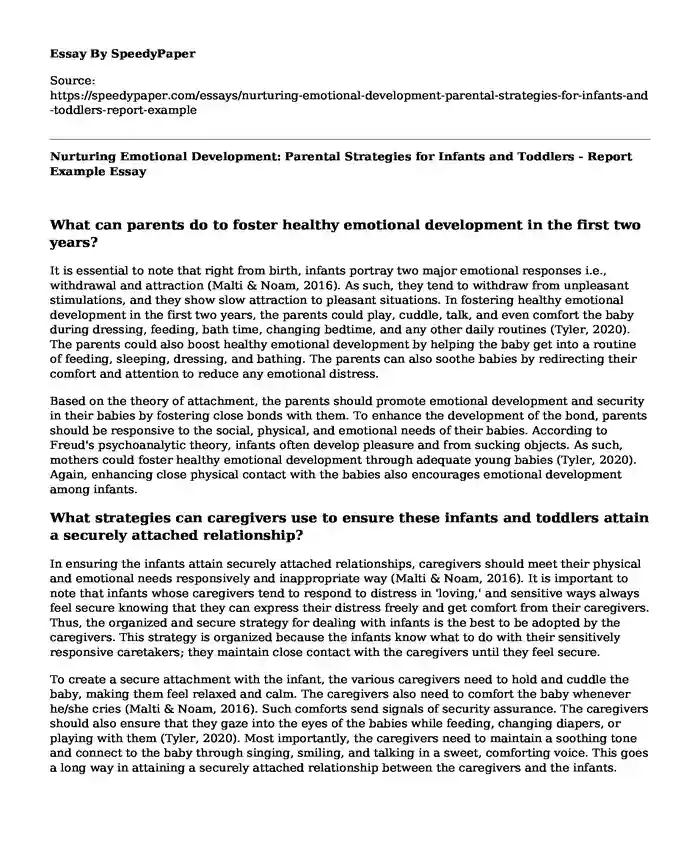
| Type of paper: | Essay |
| Categories: | Childhood Development Emotional intelligence |
| Pages: | 3 |
| Wordcount: | 643 words |
What can parents do to foster healthy emotional development in the first two years?
It is essential to note that right from birth, infants portray two major emotional responses i.e., withdrawal and attraction (Malti & Noam, 2016). As such, they tend to withdraw from unpleasant stimulations, and they show slow attraction to pleasant situations. In fostering healthy emotional development in the first two years, the parents could play, cuddle, talk, and even comfort the baby during dressing, feeding, bath time, changing bedtime, and any other daily routines (Tyler, 2020). The parents could also boost healthy emotional development by helping the baby get into a routine of feeding, sleeping, dressing, and bathing. The parents can also soothe babies by redirecting their comfort and attention to reduce any emotional distress.
Based on the theory of attachment, the parents should promote emotional development and security in their babies by fostering close bonds with them. To enhance the development of the bond, parents should be responsive to the social, physical, and emotional needs of their babies. According to Freud's psychoanalytic theory, infants often develop pleasure and from sucking objects. As such, mothers could foster healthy emotional development through adequate young babies (Tyler, 2020). Again, enhancing close physical contact with the babies also encourages emotional development among infants.
What strategies can caregivers use to ensure these infants and toddlers attain a securely attached relationship?
In ensuring the infants attain securely attached relationships, caregivers should meet their physical and emotional needs responsively and inappropriate way (Malti & Noam, 2016). It is important to note that infants whose caregivers tend to respond to distress in 'loving,' and sensitive ways always feel secure knowing that they can express their distress freely and get comfort from their caregivers. Thus, the organized and secure strategy for dealing with infants is the best to be adopted by the caregivers. This strategy is organized because the infants know what to do with their sensitively responsive caretakers; they maintain close contact with the caregivers until they feel secure.
To create a secure attachment with the infant, the various caregivers need to hold and cuddle the baby, making them feel relaxed and calm. The caregivers also need to comfort the baby whenever he/she cries (Malti & Noam, 2016). Such comforts send signals of security assurance. The caregivers should also ensure that they gaze into the eyes of the babies while feeding, changing diapers, or playing with them (Tyler, 2020). Most importantly, the caregivers need to maintain a soothing tone and connect to the baby through singing, smiling, and talking in a sweet, comforting voice. This goes a long way in attaining a securely attached relationship between the caregivers and the infants.
Practices that Contribute to Insecurely Attached Relationships
Insecurely attached relationships emanate from insensitivity and inconvenience to the needs of the child. A caregiver who is normally unavailable due to substance abuse, marital tension, and or preoccupation sends a message to the infant that such caregivers cannot be relied upon (Tyler, 2020). When the babies learn that they cannot rely on the caregivers to meet their needs, they tend to be frustrated hence avoiding contact with the caregivers. Insecurely disorganized attachments occur when the child receives confused, mixed, or inappropriate responses from the caregivers. Such babies who receive sporadic attention while facing discomfort may fail to learn how to calm down. The children's reassurance to calm down may not satisfy their doubts (Malti & Noam, 2016). When a caregiver laughs when a child is hurting, the baby may not learn to interpret emotions. As such, they find it difficult to connect with unpredictable caregivers.
References
Tyler, S. (2020). Cognitive Development in Infancy & Toddlerhood. Human Behavior and the Social Environment I. https://uark.pressbooks.pub/hbse1/chapter/cognitive-development-in-infancy-toddlerhood_ch_11/
Malti, T., & Noam, G. G. (2016). Social-emotional development: From theory to practice. European Journal of Developmental Psychology, 13(6), 652-665. https://doi.org/10.1080/17405629.2016.1196178
Cite this page
Nurturing Emotional Development: Parental Strategies for Infants and Toddlers - Report Example. (2024, Jan 08). Retrieved from https://speedypaper.net/essays/nurturing-emotional-development-parental-strategies-for-infants-and-toddlers-report-example
Request Removal
If you are the original author of this essay and no longer wish to have it published on the SpeedyPaper website, please click below to request its removal:
- Literary Essay Sample: Death of a Salesman vs The White Heron
- Free Essay: How Corporate Governance Is Implemented in the UK
- Essay Example on Video Games and Real-World Violence
- Free Essay: Experiences with Race and Assimilation
- Global Inequities Essay Sample
- Essay Sample on Social Inequality in Education System
- Free Essay Sample. The Farming of Bones
Popular categories




